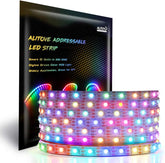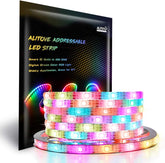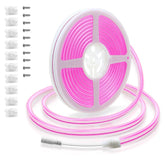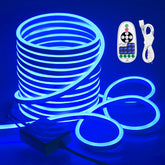Green Disposal: How to Handle Old LED Strip Lights
In today’s eco-conscious world, the way we dispose of our old LED strip lights can make a significant impact on the environment. Understanding the environmental impact of discarded strip lights is crucial, and that’s why proper disposal of LED strip lights matters more than ever. In this comprehensive guide, I’ll walk you through a step-by-step process for recycling LED strip lights, highlight local recycling programs, and even share some DIY methods for repurposing old LED strip lights.
We’ll also discuss common mistakes to avoid when disposing of strip lights and how to find certified e-waste recycling centers. Plus, I’ll delve into the role of manufacturers in LED strip light recycling and explore innovative technologies that are making recycling easier and more efficient. Finally, we’ll take a look at the future of sustainable lighting and what lies beyond LED strip lights.
1. Understanding the Environmental Impact of Discarded Strip Lights
Discarded LED strip lights can have a significant environmental impact if not disposed of properly. These lights contain materials such as metals, plastics, and electronic components that can leach harmful substances into the soil and water if they end up in landfills. Additionally, improper disposal can contribute to the growing problem of electronic waste (e-waste), which poses serious environmental and health risks. By understanding the environmental impact, we can take steps to minimize harm and promote sustainable practices.
2. Why Proper Disposal of LED Strip Lights Matters
Proper disposal of LED strip lights is crucial for several reasons. First, it helps prevent the release of toxic substances into the environment. Second, it allows for the recovery and recycling of valuable materials, reducing the need for new raw materials and conserving natural resources. Third, responsible disposal supports the circular economy, where products are reused, repaired, and recycled, ultimately reducing waste and promoting sustainability.
3. Step-by-Step Guide to Recycling LED Strip Lights
Recycling LED strip lights involves several steps to ensure they are disposed of correctly. First, remove the strip lights from their fixtures and separate any attached components, such as power supplies or connectors. Next, check with your local recycling center to see if they accept LED strip lights and follow their guidelines for drop-off or collection. If your area does not have a recycling program, consider mailing the lights to a certified e-waste recycler. Finally, make sure to handle the lights carefully to avoid damage and potential hazards.
4. Local Recycling Programs for LED Strip Lights
Many communities have local recycling programs that accept LED strip lights and other electronic waste. These programs often provide convenient drop-off locations or scheduled collection events. To find a recycling program near you, check with your local government or waste management agency. Some retailers and manufacturers also offer take-back programs, where you can return old LED strip lights for proper recycling. Participating in these programs helps ensure that your discarded lights are handled responsibly.
5. DIY Methods for Repurposing Old LED Strip Lights
If your old LED strip lights are still functional, consider repurposing them for new uses around your home. For example, you can use them to create ambient lighting in a different room, illuminate a workspace, or add decorative accents to furniture. Repurposing not only extends the life of the lights but also reduces waste and saves money. Get creative and think of innovative ways to give your old LED strip lights a second life.
6. Common Mistakes to Avoid When Disposing of Strip Lights
When disposing of LED strip lights, it’s important to avoid common mistakes that can harm the environment or pose safety risks. One common mistake is throwing the lights in the regular trash, which can lead to improper disposal and environmental contamination. Another mistake is attempting to dismantle the lights without proper knowledge or tools, which can result in injury or damage. Always follow proper disposal guidelines and seek professional assistance if needed.
7. How to Find Certified E-Waste Recycling Centers
Certified e-waste recycling centers are facilities that adhere to strict environmental and safety standards for handling electronic waste. To find a certified center, you can search online directories, check with your local government, or contact e-waste recycling organizations. Look for certifications such as R2 (Responsible Recycling) or e-Stewards, which indicate that the facility meets high standards for responsible recycling. Using certified centers ensures that your LED strip lights are recycled safely and ethically.
8. The Role of Manufacturers in LED Strip Light Recycling
Manufacturers play a crucial role in the recycling of LED strip lights by designing products with recyclability in mind and offering take-back programs. Some manufacturers use eco-friendly materials and modular designs that make it easier to disassemble and recycle the lights. Additionally, take-back programs allow consumers to return old lights directly to the manufacturer for proper recycling. By supporting manufacturers that prioritize sustainability, we can encourage more responsible production and disposal practices.
9. Innovative Technologies for Recycling LED Strip Lights
Advancements in recycling technology are making it easier and more efficient to recycle LED strip lights. For example, new methods for separating and recovering valuable materials from electronic waste are being developed. These technologies can extract metals, plastics, and other components for reuse in new products. Additionally, innovations in chemical recycling can break down complex materials into their basic elements, allowing for more comprehensive recycling. Staying informed about these technologies can help us adopt better recycling practices.
10. The Future of Sustainable Lighting: Beyond LED Strip Lights
As we look to the future, sustainable lighting solutions will continue to evolve beyond LED strip lights. Emerging technologies such as organic LEDs (OLEDs) and quantum dot LEDs (QLEDs) offer even greater energy efficiency and environmental benefits. Additionally, smart lighting systems that integrate with home automation can optimize energy use and reduce waste. By staying informed about these advancements, we can make more sustainable choices and contribute to a greener future.

Discover Local Recycling Programs: Find a Certified E-Waste Center Near You!
Conclusion
Properly handling and recycling old LED strip lights is a crucial step towards a more sustainable and eco-friendly future. By understanding the environmental impact, following proper disposal guidelines, and exploring innovative recycling technologies, we can significantly reduce e-waste and conserve valuable resources. Whether you choose to repurpose your old lights, participate in local recycling programs, or support manufacturers with take-back initiatives, every effort counts. Let’s commit to greener disposal practices and make a positive impact on our planet, one LED strip light at a time.
Quote
-
SustainWiki - “How to Dispose of LED Light Strips?”
-
Bright Light Hub - “How to Dispose of LED Strip Lights - 7 Effective Ways (2024)”
-
Earth911 - “How to Recycle LED Light Bulbs”
-
Waveform Lighting - “Are LED Lamps Considered Universal Waste? How To Dispose of LED Lamps Properly”





















Leave a comment
Please note, comments need to be approved before they are published.